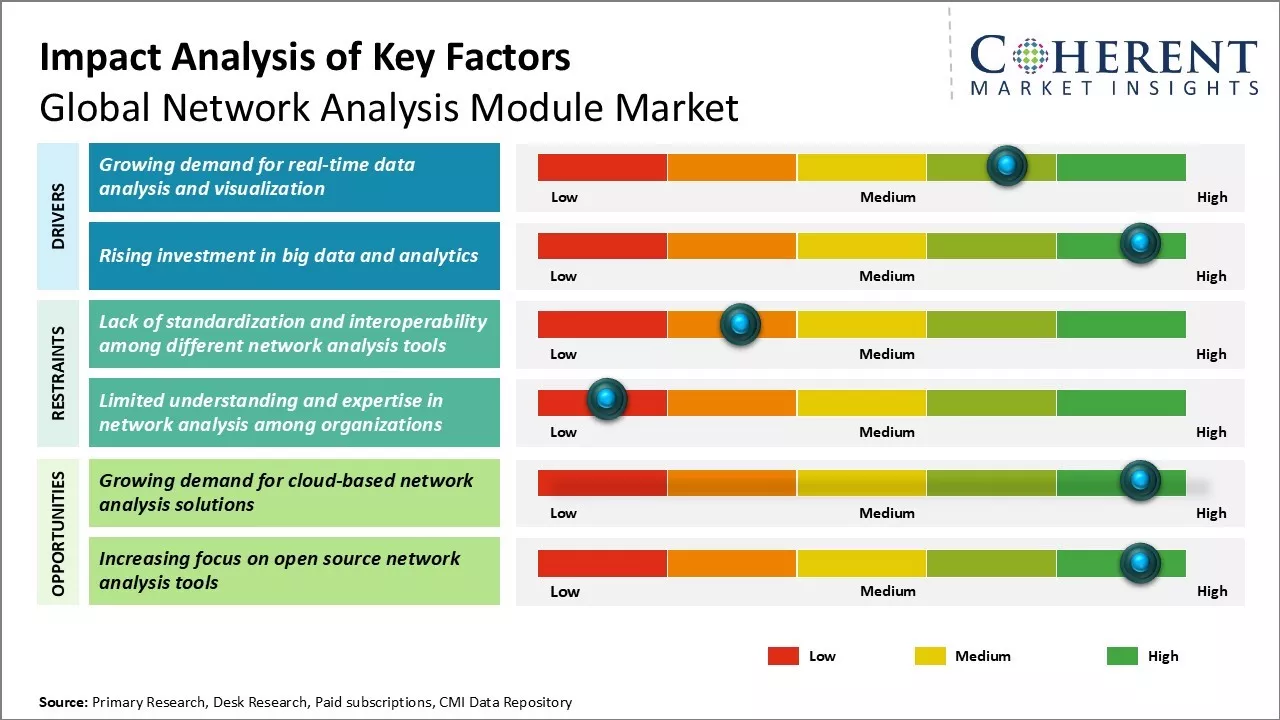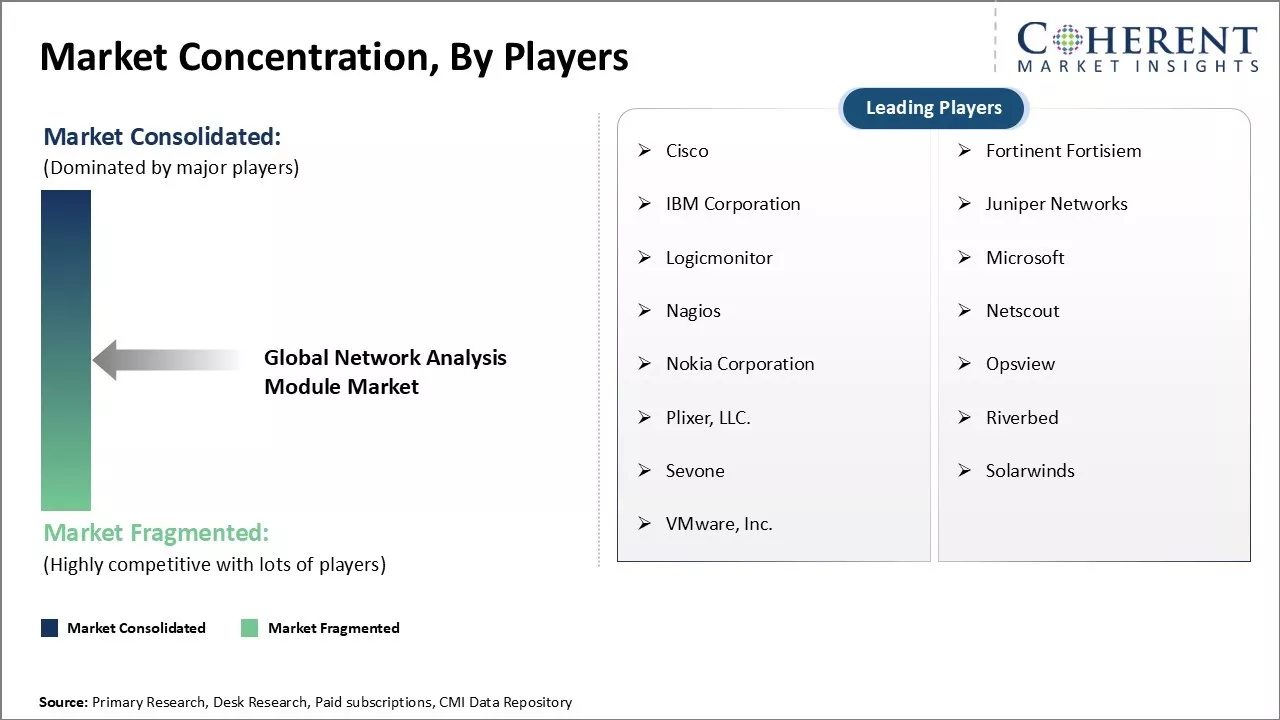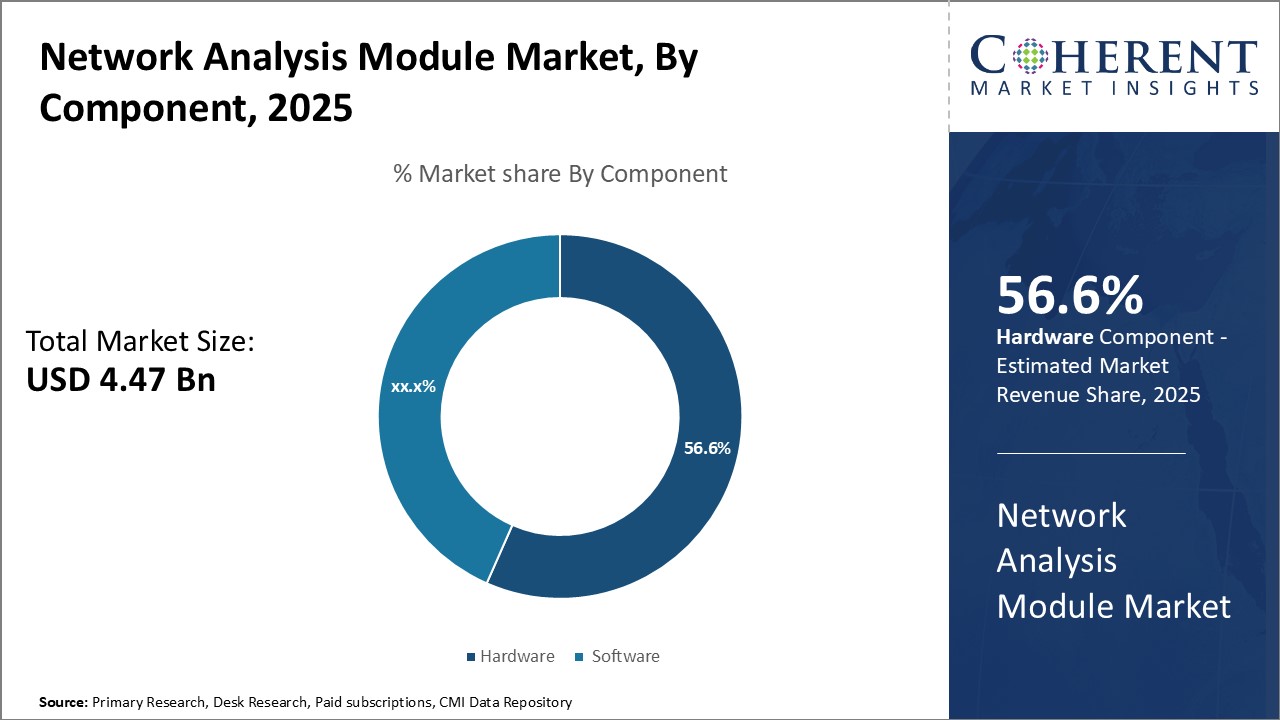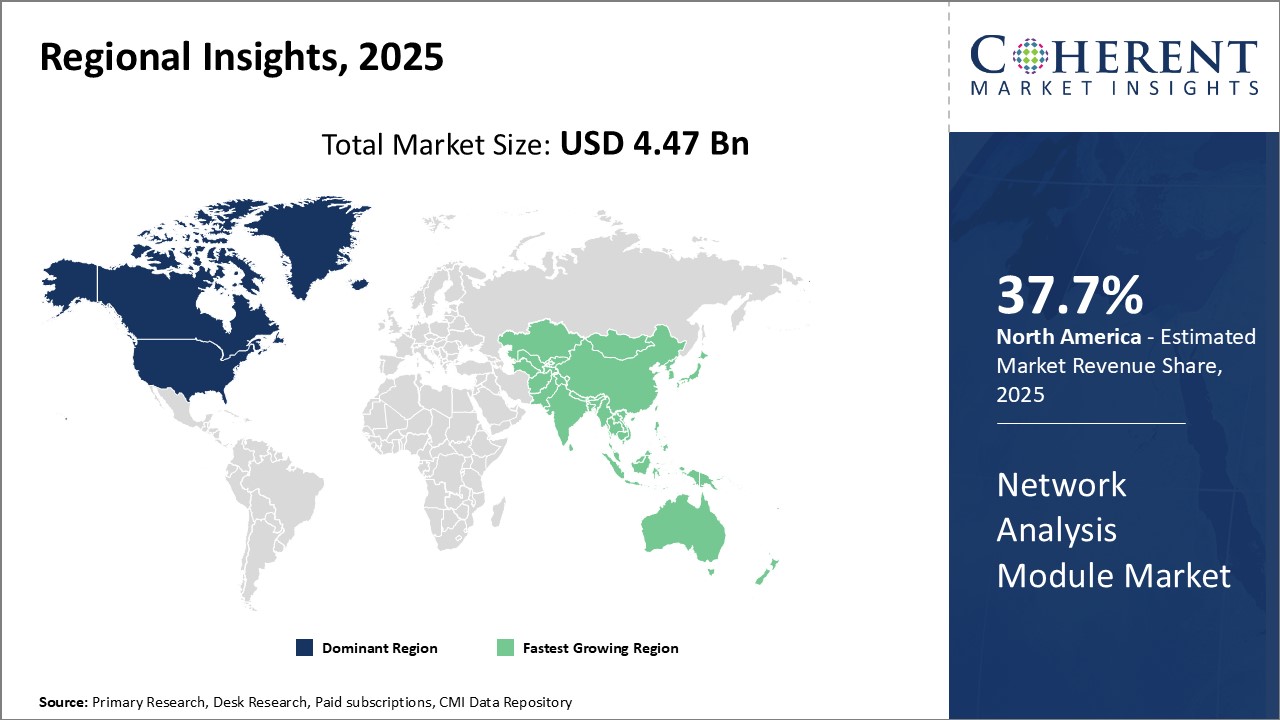Network Analysis Module Market Size and Trends
The global network analysis module market is estimated to be valued at USD 4.47 Billion in 2025 and is expected to reach USD 18.96 Billion by 2032, exhibiting a compound annual growth rate (CAGR) of 22.9% from 2025 to 2032. This is attributed to factors such as rising demand for network analysis across various industry verticals for applications including network modelling, pattern detection, and security and management.

Discover market dynamics shaping the industry: Download Free Sample
Increasing deployment of cloud applications and services is positively impacting the adoption of network analysis modules. Various organizations such as Cisco, Fortinent Fortisiem, IBM Corporation, Juniper Networks, Logicmonitor, Microsoft, etc. are increasingly implementing network analysis solutions to gain insights from the massive volume of network traffic data generated each day. Further technological advancements in network analysis with capabilities such as real-time monitoring and advanced data analytics are expected to drive greater demand. However, issues pertaining to data privacy and security may hamper the market growth to some extent during the forecast period.
Market Driver - Growing demand for real-time data analysis and visualization
With the rapid digitization across all industries, data has become one of the most valuable assets for any organization. However, analyzing large volumes of data in a timely manner continues to pose major challenges. Traditional data analysis tools are unable to process real-time streaming data and provide prompt insights. On the other hand, network analysis has emerged as a powerful approach to map relationships and interactions within large and complex datasets. Businesses are recognizing the potential of network analysis to derive meaningful patterns and structures from real-time data flows. This helps organizations gain a holistic understanding of dynamic systems and make quicker decisions.
For instance, In August 2023, TPG Telecom, a prominent Australian telecommunications company, partnered with Ericsson, a global leader in communications technology, to launch a cloud-native and AI-powered analytics tool aimed at enhancing network performance. This collaboration will enable TPG Telecom to gain valuable insights from its fixed wireless access, 4G, and 5G mobile, as well as Internet of Things (IoT) subscribers, utilizing advanced data collection methods with embedded intelligence to predict, prioritize, and resolve performance issues in real-time.
Market Concentration and Competitive Landscape

Get actionable strategies to beat competition: Download Free Sample
Rising Investment in Big Data and Analytics
Business leaders across the globe are increasingly making significant investments in data-driven transformation as a strategic priority. While organizations had been collecting massive volumes of structured and unstructured data over the past decade, insights remained untapped due to the lack of skills and appropriate technologies. However, mature big data and advanced analytics are now empowering companies from diverse industries to gain competitive advantages by leveraging information assets effectively. Continuous technological advancements are also making it possible to store, process, and analyze exabytes of data today.
As big data initiatives take center stage, there is growing focus on network analysis as a specialized technique. Extracting value from unstructured data often involves mapping relationships and interactions which traditional analytics struggles to address. Network modules offer capabilities for automated construction of relationship graphs, detection of patterns over connected entities and visualization of dynamics which are crucial for big data use cases. Several enterprises are implementing such solutions to drive insights from domains like supply chain optimizations, fraud detections, risk management, medical research and more.
Key Takeaways from Analyst:
The global network analysis module market is expected to witness steady growth in the coming years driven by rising demand for advanced network monitoring tools from large enterprises. These modules provide valuable insights into network usage patterns and help improve network visibility. They also enable granular traffic analysis which is crucial for maintaining network performance and security. However, high initial costs of deployment and need for skilled professionals to use advanced features remain key challenges.
The North American region currently dominates the market and is expected to continue its lead helped by presence of major players and early technological adoption among organizations. However, the Asia Pacific region is likely to see fastest growth on back of rising connectivity needs of growing economies and increasing investments in digital technologies by enterprises in China, India and other developing nations. The network analysis module market in Europe will also grow steadily due to availability of specialized security solutions and initiatives promoting adoption of advanced IT infrastructure.
Key players such as Microsoft, Nagios, Netscout, Nokia Corporation, Opsview, Plixer, etc. are focused on introducing enhanced modules integrated with benefits of machine learning, virtual assistants and predictive capabilities. This will help users tackle complex network management issues effectively. Integration of modules with cloud and development of compatible software as a service offering are also growth areas. Overall, the global network analysis module market has strong prospects for vendors able to offer innovative features tailored to different industry needs.
Market Challenge - Lack of standardization and interoperability among different network analysis tools
One of the key challenges for the global network analysis module market is the lack of standardization and interoperability among different network analysis tools offered by various vendors. Each vendor has developed their own proprietary tools and platforms for network analysis which do not allow interoperability with tools from other vendors. This siloed approach has created issues for organizations using multiple best-of-breed tools from different vendors for their network management and security needs. The lack of standard interfaces and data formats among these tools limits the ability to integrate and correlate insights and findings from different tools. This poses challenges for organizations to gain a holistic view of their network behavior and security posture. To address security threats and issues effectively, there is a need for network tools to communicate and exchange metadata and findings seamlessly. However, in the absence of common standards, integration of tools from different vendors continues to be difficult and costly for organizations.
Opportunity - Growing demand for cloud-based network analysis solutions
One of the major opportunities for vendors in the global network analysis module market is the growing demand for cloud-based network analysis solutions. With the rise of cloud computing and hybrid work environments, there is an increasing need for network visibility and security across distributed IT infrastructures. Traditional on-premise network analysis tools are unable to provide the required scalability and flexibility for hybrid networks spread over cloud, physical locations, and remote user environments. Cloud-based network analysis platforms offer clear advantages in terms of deployed cost, maintenance, and scalability. They also allow organizations to analyze network traffic and threat patterns from multiple locations through a single unified platform. This has spurred demand for Software-as-a-Service-based network analysis modules. Key network equipment and security vendors are also integrating cloud capabilities with their tools to capitalize on this opportunity. The growth in cloud-first businesses is expected to further accelerate the demand for scalable cloud-native network analysis solutions.

Discover high revenue pocket segments and roadmap to it: Download Free Sample
By Component - Technological Dependence Drives Hardware Demand
In terms of component, hardware segment is estimated to hold 56.6% share of the market in 2025 owing to its indispensable role in network analysis. No network monitoring can take place without the physical networking equipment that collects and processes data. Routers, switches, access points and other network devices are essential for capturing traffic flows, endpoint connections and protocol activities across the network infrastructure. Their hardware sensors, processors and storage capabilities are what enable real-time visualization and troubleshooting of network activities.
Given the complexities of modern networks that span multiple locations, vendors, and technologies, hardware components play a key role in integrating data from diverse sources for a unified view. Advanced hardware such as network taps, network packet brokers and sensor appliances are capable of monitoring very high traffic volumes and speeds, which is critical for large enterprise and service provider networks. Their high-performing hardware specs allow capturing even brief latency issues or security anomalies in terabit networks.
Furthermore, enterprises prefer hardware-based network monitoring solutions for their stability, reliability and long life. Hardware appliances can run continuously for years without downtime needed for software upgrades or troubleshooting incompatible code. Enterprises value minimize operational disruptions to their critical networks. This makes hardware an essential reliability factor, even as software-based solutions improve. Deploying updated software also requires additional IT effort for testing and migration, which hardware avoids by offering stable, long-term deployments.
As network infrastructures migrate to emerging technologies like 5G, SD-WAN and Internet of Things (IoT), there will be a growing need to retrofit legacy systems with new hardware for protocol decoding, traffic filtering and security controls. Network functions are also shifting to edge locations, pushing for distributed monitoring hardware. These transitions highlight the irreplaceable need for continued hardware innovations to ensure ubiquitous network coverage. Going forward, hardware will remain the cornerstone that builds on software capabilities for comprehensive network analysis.
By Deployment Mode - Enterprise Security Needs Drive On-Premises Adoption
In terms of deployment mode, on-premises segment is estimated to dominate market revenue share with 65% in 2025 due to enterprises' stringent security requirements. For network monitoring of confidential intranet infrastructure and enterprise applications, many companies are reluctant to adopt public cloud-based solutions due to data privacy and regulatory compliance concerns. Storing and processing sensitive network traffic data and security logs outside of organizational boundaries increases risks of data breaches and leakage.
Additionally, network activities often contain personnel details, intellectual property and confidential communications that must stay within infrastructure that the company owns and controls. Public cloud services may be subject to unseen vulnerabilities, geo-restriction risks or unclear legal jurisdictions in case of disputes. Therefore, to ensure complete oversight and protection of critical network data, enterprises gravitate towards deploying monitoring tools on their managed internal infrastructure.
The on-premises model also addresses latency issues that cloud-based analysis may face in capturing real-time traffic. Millisecond response times are essential for identifying distributed denial-of-service (DDoS) attacks and malware infections accurately. Network events must be detected, correlated and mitigated instantly within the private network perimeter for maximum security effectiveness. Moreover, regulated industries like healthcare, finance and government have additional compliance needs for data residency that on-premises solutions can fulfill.
While cloud-based offerings provide advantages of scalability, availability and reduced costs in some non-sensitive use cases, enterprises prioritize vigilance over visibility. For core network oversight that verifies security controls and validates policy adherence, on-premises deployments retain the strongest industry preference among privacy-conscious organizations. This validates this model's prominence in serving varied enterprise security mandates.
By End User - IT Ops Drives Highest Adoption among Professionals
In terms of end user, IT and telecom segment is estimated to contribute the 32.9% share of the market in 2025 owing to the sector's intensive networking demands. As the backbone industry supporting business and consumer connectivity worldwide, telecom networks scale massively to provide high-speed internet, voice and multimedia services. IT infrastructure powers today's digital workplaces and technologies globally. Both sectors rely on vast, complex and mission-critical networks that require round-the-clock vigilance.
Network operations teams in IT and telecom shoulder immense responsibilities of maintaining performance, availability and security for business-integral systems. Amid expanding attack surfaces and user dependencies, enhanced network visibility has become a top priority for operations professionals to preempt issues and reduce downtime costs. Comprehensive network analysis tools allow proactive detection of degradations as well as active threats across telepresence, cloud, unified communications and collaboration systems.
Additionally, IT and telecom networks generally involve intricate routing configurations, proprietary protocols and bespoke integration workflows. Their networks also integrate a higher number of partner technologies through business alliances. As a result, these industries demand highly flexible analysis modules with extensive protocol decoding, customizable views and Omni channel partner integrations for thorough oversight. Also, with networks serving revenue-generation, these sectors are more willing to invest in premium visibility tools.
In contrast, while network usage is growing rapidly in other industries as well, many lack internal IT expertise to fully leverage analysis capabilities. For price-sensitive sectors, basic network monitoring may suffice. However, for the professionals managing mission-critical networks at scale globally, advanced network analysis proves an indispensable management tool. This cements IT and telecom as the largest adopters.
Regional Insights

Need a Different Region or Segment? Download Free Sample
North America has established itself as the dominant region in the global network analysis module market with an estimated 37.7% share in 2025. The region has a strong footprint of leading network analysis solution providers as well as a vast customer base across industries. The presence of major cloud service providers and their continued investments in building robust network infrastructure has created immense opportunities for network analysis module vendors in the region. Moreover, a culture of rapidly adopting emerging technologies coupled with stringent regulatory guidelines driving the need for advanced networking solutions provides a conducive environment for market growth. For instance, In September 2023, The U.S. Food and Drug Administration (FDA) has issued final guidance on "Cybersecurity in Medical Devices," which outlines essential considerations for manufacturers regarding the security of connected devices. This guidance stresses the importance of conducting thorough cybersecurity risk analyses and implementing mitigation strategies before submitting products for approval. The FDA's focus on cybersecurity is particularly relevant for network analysis modules used in healthcare settings, where data integrity and patient safety are paramount.
The Asia Pacific region has emerged as the fastest growing market for network analysis modules globally on account of the thriving digital transformation taking place across industries. In particular, countries like China and India stand out due to their huge populations and rapidly growing economies. The massive expansion of internet and smartphone penetration paired with government initiatives to build 'Smart Cities' significantly impact the global network analysis module market by promoting advanced technologies and infrastructure improvements. One notable example is the Smart Cities Mission launched by the Government of India on June 25, 2015. At the same time, countries in Southeast Asia such as Vietnam, Indonesia, and the Philippines are witnessing explosive growth in their IT infrastructure which is positively impacting the adoption of network analysis modules. Rapid industrialization and the need to improve efficiency through digitization provide tailwinds for further growth prospects in Asia Pacific. The region is set to take over other mature markets in terms of revenue generation in the coming years.
Market Report Scope
Network Analysis Module Market Report Coverage
| Report Coverage | Details | ||
|---|---|---|---|
| Base Year: | 2024 | Market Size in 2025: | USD 4.47 Bn |
| Historical Data for: | 2020 To 2024 | Forecast Period: | 2025 To 2032 |
| Forecast Period 2025 to 2032 CAGR: | 22.9% | 2032 Value Projection: | USD 18.96 Bn |
| Geographies covered: |
|
||
| Segments covered: |
|
||
| Companies covered: |
Cisco, Fortinent Fortisiem, IBM Corporation, Juniper Networks, Logicmonitor, Microsoft, Nagios, Netscout, Nokia Corporation, Opsview, Plixer, LLC., Riverbed, Sevone, Solarwinds, and VMware, Inc. |
||
| Growth Drivers: |
|
||
| Restraints & Challenges: |
|
||
Uncover macros and micros vetted on 75+ parameters: Get instant access to report
Network Analysis Module Industry News
- In September 2023, Ericsson (NASDAQ: ERIC), a leading global provider of information and communications technology, expanded its Ericsson Expert Analytics product by introducing advanced troubleshooting capabilities. This new functionality leverages machine learning and artificial intelligence tools to analyze telecom network data in real-time and determine the root cause of any occurring issues for efficient troubleshooting.
- In August 2023, SK Telecom Co., a leading South Korea-based telecommunications company, unveiled an innovative analytics solution and simulator tailored for Urban Air Mobility (UAM) communication networks. This advanced system utilizes drones to replicate real-time communication scenarios for UAM vehicles, assessing aerial communication quality at altitudes between 300 to 600 meters and speeds of 100 to 150 km/h. The drones will collect data across various air routes, including urban and suburban areas, enabling SK Telecom to conduct thorough evaluations of the communication network's performance.
- In April 2023, Accenture (NYSE: ACN), a leading global professional services company, announced an expansion of its partnership with Google Cloud, a prominent provider of cloud computing services, to enhance businesses' protection of critical assets and bolster security against persistent cyber threats. By leveraging Google Cloud's advanced technologies in data analytics, machine learning (ML), artificial intelligence (AI), and cybersecurity, the collaboration aims to help organizations build more resilient digital infrastructures and improve their overall security posture.
- In February 2023, Cisco (NASDAQ: CSCO), a global leader in technology that powers the Internet, announced a partnership with V.tal, Brazil's first end-to-end neutral fiber-optic network provider. This collaboration aims to enhance the capacity of V.tal's multi-tenant fiber network to accelerate the rollout of 5G services and improve nationwide connectivity, supporting the future of the Internet across Brazil. V.tal operates the largest fiber-optic infrastructure in the country, with 450,000 kilometers of terrestrial optical fiber connecting over 2,380 municipalities.
*Definition: The Global Network Analysis Module Market provides software tools and solutions that allows organizations to analyze their network infrastructure and detect vulnerabilities, threats, and anomalies across geographically distributed networks in real-time. It offers network visualization, traffic analysis, configuration auditing, asset management, and security event monitoring capabilities through an integrated module. This helps network operations and security teams gain insights into network behavior to optimize performance, identify issues, and protect the network.
Market Segmentation
- Component Insights (Revenue, USD Bn, 2020 - 2032)
- Hardware
- Software
- Deployment Mode Insights (Revenue, USD Bn, 2020 - 2032)
- On-Premises
- Cloud-Based
- End User Insights (Revenue, USD Bn, 2020 - 2032)
- IT and Telecom
- BFSI
- Healthcare
- Manufacturing
- Energy and Utilities
- Others (Transportation, Government, etc.)
- Regional Insights (Revenue, USD Bn 2020 - 2032)
-
- North America
- U.S.
- Canada
- Latin America
- Brazil
- Argentina
- Mexico
- Rest of Latin America
- Europe
- Germany
- U.K.
- Spain
- France
- Italy
- Russia
- Rest of Europe
- Asia Pacific
- China
- India
- Japan
- Australia
- South Korea
- ASEAN
- Rest of Asia Pacific
- Middle East
- GCC Countries
- Israel
- Rest of Middle East
- Africa
- South Africa
- North Africa
- Central Africa
- North America
- Key Players Insights
- Cisco
- Fortinent Fortisiem
- IBM Corporation
- Juniper Networks
- Logicmonitor
- Microsoft
- Nagios
- Netscout
- Nokia Corporation
- Opsview
- Plixer, LLC.
- Riverbed
- Sevone
- Solarwinds
- VMware, Inc.
Share
Share
About Author
Ankur Rai is a Research Consultant with over 5 years of experience in handling consulting and syndicated reports across diverse sectors. He manages consulting and market research projects centered on go-to-market strategy, opportunity analysis, competitive landscape, and market size estimation and forecasting. He also advises clients on identifying and targeting absolute opportunities to penetrate untapped markets.
Missing comfort of reading report in your local language? Find your preferred language :
Transform your Strategy with Exclusive Trending Reports :
Frequently Asked Questions
EXISTING CLIENTELE
Joining thousands of companies around the world committed to making the Excellent Business Solutions.
View All Our Clients

